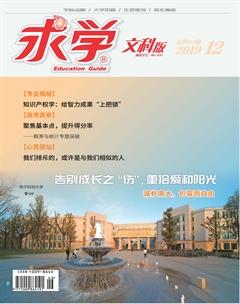“点缀”平凡句子,使英文“异彩纷呈”
王静
近年来,高考命题者加大了对句子结构和知识面的考查力度,同时注重考查知识之间的交叉和语法知识。特殊句式中的强调句、倒装句、省略句是高考的热点,主要出现在单选题、语法填空题、语篇阅读中,还可运用于我们的写作之中。因此,在复习和备考中我们要注意总结、深入研究,全面把握英语的特殊句式。
一、强调句
强调是有效地进行思想交流的重要手段之一。人们在交际过程中,为了使自己的想法能被听者或读者恰当地理解,必须突出重要的内容,这就需要运用强调的手段。在英语中,人们常常用强调句来进行交流。
考点一:强调句的基本形式:It is/was+被强调部分+that/who+其他部分。
此句型可以对句中的主语、宾语、状语等进行强调。强调事物或情况时,只能用that;强调人时,用that,who均可。
【例1】(2017·天津卷·11)It was when I got back to my apartment ____I first came across my new neighbors.
A. whoB. whereC. whichD. that
【解析】D。句意:当我回到我的公寓的时候,我第一次遇见了我的新邻居。本句去掉It was和that后,成为“when I got back to my apartment, I first came across my new neighbors.”,这句话的句意是完整的,所以确定是强调句型,故选D。
考点二:强调句的一般疑问句:Is/Was it+被强调部分+that/who...?
【例2】Was it near the building, if I may ask, _____Martin Luther King gave the speech“I have a dream”?
A. whereB. whichC. thatD. when
【解析】C。句子被强调的部分是near the building。句意:如果我可以问的话,马丁·路德·金是不是在这栋楼附近做了《我有一个梦想》的演讲啊?
考点三:强调句的特殊疑问句: 特殊疑问词+is/was+it that...?
【例3】—____you raised your work efficiency so much?
—Oh, we have introduced some modern equipment.
A. How it is that B. How is it that
C. How it was thatD. How was it that
【解析】D。句意:“你们是怎么把工作效率提高这么多的?”“噢,我们引进了一些现代设备。”分析句子的结构和选项可知,本题考查强调句的特殊疑问句,即“特殊疑问词+is/was+it that...?”,由问句中的“raised”可知应使用一般过去时,故选D。
·易错点拨·
如果强调句的特殊疑问句作宾语从句,要用陈述语序。
【例4】Up till now, there has been no scientific evidence about _______ caused the death of dinosaurs.
A. what is it that B. what it was that
C. it was whatD. what is it
【解析】B。句意:到目前為止,还没有科学证据证明是什么导致恐龙的死亡。句子强调恐龙灭绝的原因,即what,因此这是一个强调句的特殊疑问句,强调句式后面要用that,故可排除C、D两项;另外,由于这个强调句是作介词about的宾语从句,因此要用陈述语序。
考点四:对not...until...句式的强调: It was not until ...that...
对含有not...until...的句子进行强调时,应将not与until一起放入被强调部分。
错误:It was not until she took off her dark glasses did I realize she was a famous singer.
(not until不在句首,主句不需要使用部分倒装)
正确:It was not until she took off her dark glasses that I realized she was a famous singer.
注意:如果需要强调谓语,应用“do/does/did+动词原形”结构,但只能用于一般现在时和一般过去时的肯定句中。
二、倒装
英语句子的自然语序是主语在前,谓语动词在后。但为了强调句子中的某一部分,可以把原来的语序重新调整。常用的方法是将要强调的部分放在主语之前,这就叫“倒装结构”。如果全部谓语放在主语之前,叫“全部倒装”;如果只把be动词、助动词或情态动词置于主语之前,就叫“部分倒装”。
倒装是每年高考的必考语法重点,高考对倒装的命题重点主要集中在是否倒装、部分倒装还是完全倒装的辨析上,常与时态结合在一起考查,有时也结合主谓语一致进行考查。
考点一:表示方位、地点和时间的副词in,out,up,down,away,off,now,then等置于句首的完全倒装。
【例5】Hearing the dog barking fiercely, away ____.
A. fleeing the thiefB. fled the thief
C. the thief was fleeingD. was fleeing the thief
【解析】B。句意:听到狗凶猛地叫,小偷逃了。Away是副词,在句首引起倒装;flee意为“逃跑”,是不及物动词,移到主语(名词)the thief前面。此句式结构一般不用进行时。
·易错点拨·
若句子的主语是人称代词,则不用倒装。例如:Away they hurried.
考点二:表示地点、方位、时间等的介词短语放在句首,句中谓语动词常为sit,stand,lie等不及物動词且主语是名词时的完全倒装。
【例6】Just in front of the temple ____with a history of 1000 years.
A. does an old pine tree standB. stands an old pine tree
C. an old pine tree is standingD. an old pine tree stands
【解析】B。句意:一棵有千年历史的松树就矗立在寺庙的前面。表示地点的介词短语放在句首,句子要完全倒装,此句中,主语是an old pine tree with a history of 1000 years,为单数,所以谓语用第三人称单数stands。正常语序为An old pine tree with a history of 1000 years stands just in front of the temple.
·易错点拨·
在完全倒装的句子中,介词短语不可作主语,位于动词后面的名词就是句子的主语。
考点三:only修饰副词、介词短语或状语从句,放在句首时引起的主句部分倒装。
【例7】 Only when Lily walked into the office _____ that she had left the contract at home.
A. she realizedB. has she realized
C. she has realizedD. did she realize
【解析】D。句意:直到Lily走进办公室,她才意识到她把合同忘在家里了。Only修饰作状语的从句(介词短语/副词)并放在句首时,主句多用部分倒装;由宾语从句中的过去完成时可知,主句应用一般过去时。
·易错点拨·
如果only修饰名词或代词作主语放在句首,则主句不必倒装。如:Only she can do it well.
考点四:具有否定意义或半否定意义的副词never,seldom,little(少),hardly,nowhere,rarely,scarcely,not等置于句首时的部分倒装。
【例8】(2016·江苏卷·34)Not until recently ______the development of tourist-related activities in the rural areas.
A. they had encouragedB. had they encouraged
C. did they encourage D. they encouraged
【解析】C。句意:直到最近他们才鼓励在农村地区开展与旅游业有关的活动。当not until所引导的时间状语放在句首的时候,主句要使用部分倒装,排除A、D项。B项为过去完成时,上下文中并没有体现“过去的过去”的时间,故错误。C项正确。
考点五:含有否定意义的介词短语at no time (从来没有),by no means (决不),in no way (决不),in no case (决不),under no circumstances (在任何情况下都不)等置于句首时的部分倒装。
【例9】(2019·天津卷·12) The professor warned the students that on no account _____ use mobile phones in his class.
A. should they B. they should C. dare they D. they dare
【解析】A。句意:这位教授警告学生们,在他的课堂上,决不应该使用手机。on no account“决不”,否定词放在句首,句子使用部分倒装,should do“应该做”,dare do“敢于做”,根据句意此处要表达“应该”,故选A。
考点六:表示否定意义的固定搭配连词(no sooner... than...;hardly/scarcely...when...;not until...;not only...but also...;neither...nor...等)置于句首时的倒装。
【例10】No sooner stepped on the stage than the audience broke into thunderous applause.
A. had Mo Yan B. Mo Yan had
C. has Mo Yan D. Mo Yan has
【解析】A。句意:莫言一登上舞台,观众就报以雷鸣般的掌声。no sooner...than...“一……就……”,no sooner所在的句子用过去完成时,位于句首时要把had提前,构成主句部分倒装。
·易错点拨·
类似的结构有hardly/ scarcely...when...。另外,还要注意以下句型:
① not only...but also...连接两个并列句,not only位于句首,只有第一个分句用部分倒装。
Not only should we not be afraid of difficulties, but also we should try our best to overcome them.
②neither...nor...(“既不……也不……”)连接两个并列分句时,由于neither,nor都是否定词,因此前后句均用倒装结构。
Neither do I know it, nor do I care about it.
考点七:so/such...that结构中,so/such提前至句首的主句谓语的部分倒装。
【例11】So amused ____that I couldnt help laughing when I saw the children dressed up as Santa Clauses on Christmas Day.
A. did l feelB. had I feltC. was I feltD. I felt
【解析】A。在so...that结构中,“so+形容词”部分置于句首时,主句部分谓语用部分倒装,that引导的状语从句部分谓语不用倒装。另外, that从句中谓语saw是一般过去时,根据主从句时态一致性的原则,答案为A项。
考点八:省略连词if,将were/had/should提到主语之前的虚拟条件句的从句部分倒装。
【例12】(2017·江苏卷·22)_______ not for the support of the teachers, the student could not overcome her difficulty.
A. It wereB. Were itC. It wasD. Was it
【解析】B。句意:要不是老师们的支持,该生是无法克服她自己的困难的。根据主句中的“could not overcome her difficulty”可知,从句谓语动词应该用过去时,表示对现在事实的虚拟。完整的从句是if it were not for the support of the teachers,其中的if可以省略,同时将were提前,构成倒装。
考点九:so/neither + be/have/助动词/情态动词 + 主语,表示“也(不)……”的部分倒装及其相关句型。
【例13】As fuel prices rose, bus companies raised their fares and ______.
A. so did the airlinesB. nor did the airline
C. so the airlines didD. nor the airlines did
【解析】A。句意:因為燃料价格上涨,公交公司涨了票价,航空公司也是。表示“某人/物的情况也是如此”,用“so+助动词+主语”结构,故A项正确。
【例14】—As a teenager, our son should have two or three hobbies to be really happy.
—_____.But how can he afford the time with so much homework every day?
A. So does he B. So he does
C. So should heD. So he should
【解析】D 。句意:“作为一个青少年,我们的儿子应该有两三个爱好才能真正开心。”“他的确应该如此,但是他每天有这么多的家庭作业,他怎么能有时间呢?”本题考查倒装句型。So does he和So should he为倒装结构,意为“也……”,不符合语境。So he does 和So he should意为“他确实……”,符合题意。另外,根据第一句中的“our son should have...”,可以排除B项,故选D项。
【例15】—The man has great determination and never gives up.
—______.
A. So do youB. Neither do you
C. So is with youD. It is the same with you
【解析】D。句意:“那个人有决心,从不放弃。”“你也如此。”当表达前者的情况也适用于后者,而这种情况既有肯定又有否定的时候,用It is the same with... 或者So it is with...,故选D项。
考点十:as/though引导的让步状语从句的部分倒装。
【例16】Unsatisfied ____with the payment, he took the job just to get some work experience.
A. though was heB. though he was
C. he was thoughD. was he though
【解析】B。句意:尽管对工资不满意,但为了获得工作经验,他还是接受了这份工作。though引导的让步状语从句中的表语、状语或动词原形置于句首,但主谓顺序不变,故B项正确。
·易错点拨·
若表语是名词,其前面不用冠词。
Student as he is,he doesnt study as hard as he can.
三、省略
为了避免重复,突出关键词语,并使上下文紧密连接,在句子中有时就省去一个或几个句子成分。这种语法手段就称为省略。在近几年的高考试题中,省略现象尤为常见。英语中常常使用省略的句式,现总结如下:
考点一:动词不定式的省略
1.不定式在hope,intend,plan,mean,want,wish,would like/love等动词后作宾语,在ask,advise,persuade,allow,tell 等后作补语或与be able to,be going to,have to,used to等一起构成复合谓语时,常省略与上文相同的动词,只保留符号to。
【例17】The driver wanted to park his car near the roadside but was asked by the police .
A. not to doB. not toC. not doD. do not
【解析】B。句意:这个司机想把车停靠在路边,但警察叫他别那样做。短语ask sb not to do sth,其被动式为be asked not to do。其中,do即前文的park his car near the roadside,故省略,仅保留不定式符号to,故选B。
2.不定式在使役动词后或在感官动词后作补语时,why(not),had better,would rather/sooner,cannot...but...,cant help/choose...but...等后常省略to。如:
Why not join us in the discussion?
·易错点拨·
介词but,except后作宾语或be动词后作表语的不定式;如果前面有do动词,也常省略to。如:
What I have to do is stay at home.
He could do nothing but wait for the doctor to come.
考点二:状语从句中的省略
1.若从句的主语和主句的主语一致,且从句的谓语动词中含有be动词,从句的主语连同be动词一起省略。
【例18】(2018·新课标II卷)Chinas approach to protecting its environment while 70 (feed) its citizens “offers useful lessons for agriculture and food policymakers worldwide,” says the banks Juergen Voegele.
【解析】feeding。句意:中國在养活了中国人民的同时又保护了环境。这一做法为全世界的农业和粮食政策制定人提供了很有用的经验。空格处表示正在进行的动作,while后面省略掉了China is,故填feeding。
2.当见到“when(或if,where,wherever,whenever,as soon as,than等)+ possible/necessary”时,可理解中间省略了it is/was。如:
When (it is) possible, buy me some stamps.
注意:由if构成的省略结构,已属于固定短语。如if any,if necessary,if possible, if not,if so等。如:
He may be busy. If so, Ill call later. If not, can I see him now?
考点三:定语从句中的省略
1.在限制性定语从句中可省略作宾语的关系代词whom,which,that。如:
That is the naughty boy (whom/that) we talked about last week.
2.先行词为day,year,time等的定语从句中,when可省略,也可换成that;先行词为place,somewhere,anywhere,nowhere 等时,where可省略,也可换成that。如:
His father died the year (that/in which/when) he was born.
This is the place (where/that )they met yesterday.
考点四:宾语从句中的省略
1.当that引导宾语从句时,常常可以省略that,但引导第二个宾语从句的that不可省略。如:
We believe he is an honest boy and that he never lies.
2.which,when,where,how和why引导的宾语从句在其谓语与主句谓语相同时,可省略全部谓语,甚至主语也省略。如:
We will have a meeting next week, but we dont know where.
后记:特殊句式犹如夜色中的霓虹灯,点缀平凡的句子。熟练掌握并正确使用特殊句式中的强调句、倒装句、省略句,我们的作文一定会增彩还增分!

